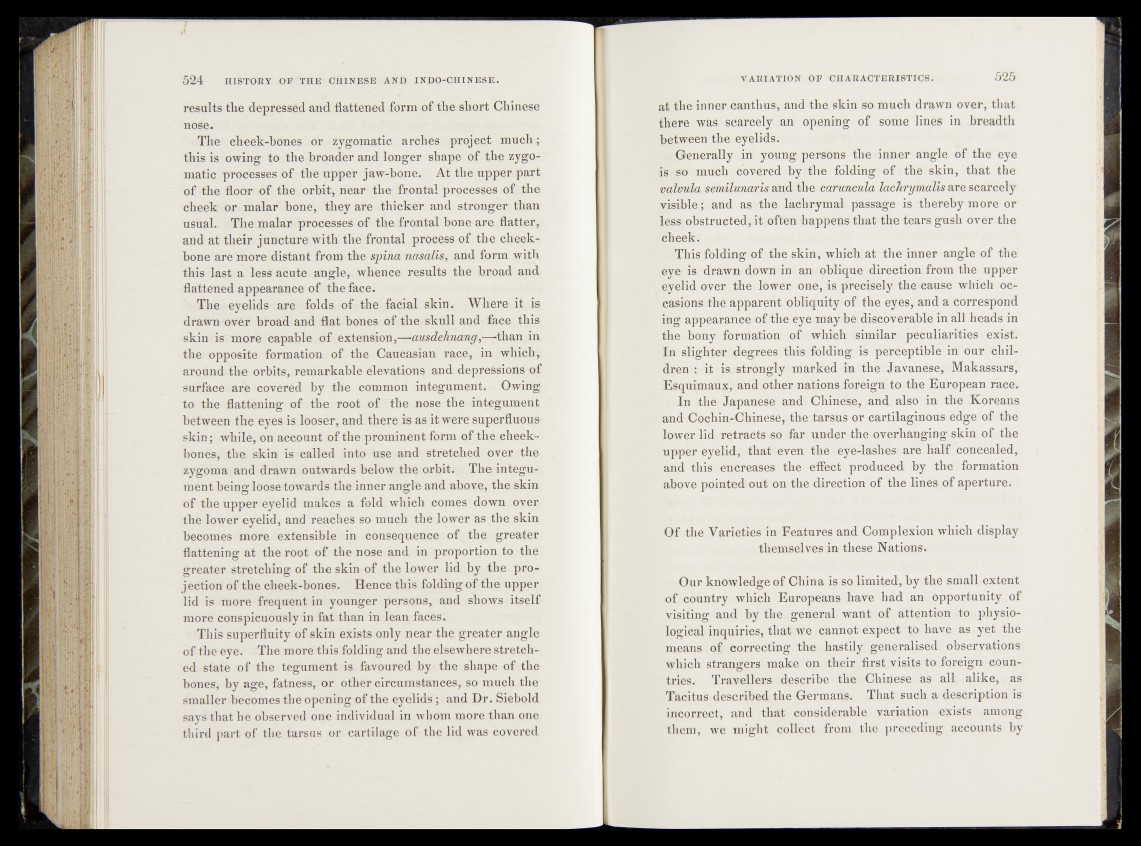
results the depressed and flattened form of the short Chinese
nose.
The cheek-bones or zygomatic arches project much;
this is owing to the broader and longer shape of the zygomatic
processes of the upper jaw-hone. At the upper part
of the floor of the orbit, near the frontal processes of the
cheek or malar hone; they are thicker and stronger than
usual. The malar processes of the frontal hone are flatter,
and at their juncture with the frontal process of the cheekbone
are more distant from the spina nasalis, and form with
this last a less acute angle, whence results the broad and
flattened appearance of the face.
The eyelids are folds of .the facial skin. Where it is
drawn over broad and flat bones of the skull and face. this
-skin is* more capable of extension,—ausdehnang,—than in
the opposite formation of the Caucasian race, in which,
around the orbits, remarkable elevations and depressions of
surface are covered by the common integument. • Öwing-
to the flattening of the root of the nose the integument
between the eyes is looser, and there is as it were superfluous
skin; while, on account of the prominent form of the cheekbones,
the skin is called into use and stretched over the
zygoma and drawn outwards below the orbit. The integument
being loose-towards the inner angle and above, the skin
of the upper eyelid makes a fold which comes down over
the lower eyelid, and reaches so much the lower as the skin
becomes more extensible in consequence of the greater
flattening at the root of the nose and in proportion to the
greater stretching of the skin of the lower lid by the pro-
j ection of the cheek-bones. Hence this folding of the uppe r
lid is more frequent in younger persons, and shows itself
more conspicuously in fat than in lean faces.
This superfluity of skin exists only near the greater angle
of the eye. The more this folding and the elsewhere stretched;
state of the tegument is_ favoured by the shape of the
bones, by age, fatness, or other circumstances, so much the
smaller becomes the opening of the eyelids; and Dr. Siebold
says that he observed one individual in whom more than one
third part of the tarsus or cartilage óf the lid was covered
at the inner can thus, and the skin so much drawn over, that
there was scarcely an opening of some lines in breadth
between the eyelids.
y. Generally in young persons the inner angle of the eye
is so much covered,by the folding of the skin, that the
valvula semilunaris and the xaruncula lachrymalis are scarcely
visible; and as the lachrymal passage is thereby more or
less obstructed, it often happens that the tears gush over the
cheek.
This folding of the skin, which at the inner angle of the
eye is drawn down in an obiique; direction from the upper
eyelid over the lower one, is precisely the cause which occasions
the apparent obliquity of the eyes, and a correspond
ing appearance of the* eye'may be discoverable in all heads in
the bony* formation of which* similar?; peculiarities-exist.
In slighter degrees-this folding; is perceptible in, our chil-
drenir'fit is, strongly marked in the Javanese, Makassars^
Esquimaux, and other nations foreign to the European race.
In the Japanese and Chinese, and also in the Koreans
and Cochin-Chines#; the tarsus or cartilaginous edge of the
lower lid retracts so far under themverhanging skinjofi the
upper eyelid, that even the eyelashes are half concealed,
and this encreases the effect produced by the formation
above pointed out on the direction of the lines of aperture.
Of the Varieties in Features and Complexion which display ,
themselves in these Nations.
Our knowledge of China is so limifcedyby the small extent
of country which Europeans have had an ^opportunity of
visiting and by the general want of attention to physiological
inquiries, that we cannot expect to-bave as yet the
means of correcting the hastily generalised observations:
which strangers make on their, first;visits to foreign coun-
tries. Travellers . describe the Chinese as all alike, as
Tacitus described the German#?; That such a 4#Sfipption is
incorrect, and that considerable variation* exists among
them, we might collect from the preceding accounts by